
In this tutorial I’ll show you how to make an under the sea cake with jelly! I’ll show you a few variations as well as tips and tricks for the easiest and most successful way to create one of these eye-catching and delicious cakes. If you prefer to watch a video of this tutorial, scroll to the bottom of the page.
First, let’s make the cake part of the cake! You’ll need a springform pan for this, which is usually used for cheesecakes and they’re the ones you can clip and unclip to separate the base and the outer ring.

Take a few layers of whatever flavor cake you like and chill them in the fridge for an hour so they’re cold and film. Place your first cake layer on the base of the springform pan and level the cake with a serrated knife if necessary, so that the next layer of cake will sit flat on top of it.

Pipe or spread your filling onto the first layer of cake. I’m using my 4 Minute Buttercream to fill and frost my cake but you can use whatever you like. It’s easiest to use a firm filling rather than something runny like lemon curd or a fruit puree because even if you pipe a buttercream dam around the filling to hold it in place, when you carve the cake if you carve off that dam your filling will ooze out of the cake.

Now carve your cake into some form of a dome by trimming the top edge off with a serrated knife so that the cake is curved around the top. It can be simple, like this, with just a few cuts to create the dome, or you can be much more elaborate, carving nooks and crannies into the top and sides of your cake.

Three things are really important when you’re carving your cake. First, keep in mind that if you want the maximum amount of cake and filling, a domed shape is best because then the cake layers will fill the middle of the cake, with a thin layer of jelly completely covering it on top and around the sides to create the effect of being under the sea.

Secondly, cakes are easiest to carve when they’re cold because they’re less crumbly so they won’t fall apart when you cut into them. You can even freeze the cake for an hour if it’s falling apart as you carve it.

Thirdly, the MOST important thing when you’re carving the cake is that the sides of the cake are at least a centimeter or 1/2 an inch within the edge fo the base of the springform pan, so that there’s room for frosting and then for the jelly to fill in the space around the outside of the cake.

If you want to, you can frost the bottom part of the cake all the way up to the edge of the base of the pan so it looks like sand at the bottom of the sea, but you’ll still need to carve the cake smaller than the pan now, so there’s room for that frosting.

It’s fine for the cake to look messy as you carve it because this is just the beginning of the process! To make the shape of your cake more interesting you can use any cake you’ve cut off to build onto it. To do this, spread some buttercream wherever you want to attach another piece of cake.

Then press the section that you carved off the cake onto the fresh buttercream and push gently to secure it. You can carve it to make a smooth join onto the existing cake but you don’t have to because you’ll be covering it with frosting, so you can use that to fill in any gaps.

Cover the cake with a thin layer of frosting. This is called a crumb coat because if any crumbs come off the cake and get into the frosting, they’ll be trapped in this layer of frosting so when you spread more frosting on later, the crumbs won’t get into that layer. Put the cake in the fridge for about 30 minutes to set this crumb coat and now I’ll show you one of the ways to make fish to swim in the jelly part of this cake.

You’ll need a silicone mold for this and some white chocolate chips. Microwave the chocolate at 50% power in the microwave for a minute to melt it without burning it and stir it until it’s smooth. You can microwave it again it there are still lumps in the chocolate.
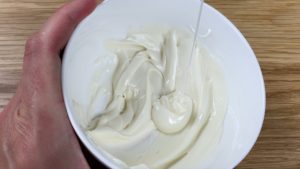
Once the chocolate is smooth, divide it into a few bowls and add a drop of gel color to each one. You can use oil based colours if you have them but the gels you use for frosting are fine if you don’t add a huge amount and don’t overstir the chocolate.

For this bowl I added a big drop of gel and there’s just a tiny bit of chocolate in the bowl so it seized up but for these other colours, with a smaller drop of colour and more chocolate in the bowl, the gels work perfectly.

Use a paintbrush to brush the coloured chocolate into the fish mold, using more than one colour within the same fish to make it look a bit more interesting and realistic. I’m using the purple chocolate that seized and since the fish is going to be within jelly on the cake, if there’s any texture or graininess in the chocolate you won’t be able to see it.

Wipe off any chocolate around the edges of the fish with an

Put the fish in the fridge for about 30 minutes to set and then flip them out of the mold and admire how pretty they look! The jelly will give them a shimmery, wet effect later. If some snap as you take them out of the mold, don’t throw them away, you can easily attach a broken tail or fin when you put the fish on the cake.

Now we’re going to frost the cake with sand. Make the colour of buttercream you want with yellow and brown gels and you can mix a few different shades if you want to create some variation. I’m going to use plain white buttercream and yellow. Spread the colours in patches onto the cake or scoop up a few colours at a time with your

You can use ganache if you prefer – it doesn’t have to be buttercream. Spread it all over the cake and smooth it a bit with your

If you’re using chocolate fish, press those into the frosting now, while the frosting is still sticky. If any of the fish broke when you took then out of the mold, just press both parts into the frosting to piece the fish back together. When you position your fish, choose the outermost parts of the cake because then the fish will be the most visible through the jelly.

The further in from the edges fo the cake, the more blurry the fish will be. They’ll look more like subtle blobs of colour than actual fish. You’ll hardly notice this fish up here because it’s so far in from the edge fo the cake.

If you’re going to leave the bottom part of the frosting visible, like this, after you frost the cake put it in the fridge for an hour to set the frosting and then scrunch up a piece of foil and wrap it around the cake, pressing to imprint some random texture in the frosting so it looks like grains of sand.
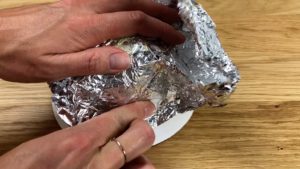
I pressed the crushed foil into the frosting all over this cake but when the cake is finished you really don’t notice the texture if there’s jelly over it, so it’s only worth doing the section of frosting that’s going to be exposed.

Now we’re going to make the jelly! You’ll need 3oz or 85g of gelatin and 1 cup of water and just to prepare you, if you’re using little packets of gelatine you’ll need a LOT of them!

Pour the gelatin and water into a bowl and leave it for 5 minutes for the gelatin to bloom, which make the jelly smooth and firm.

Put 1/2 a cup (or 100g) of sugar into a pan with 2 cups of water and bring it to a boil over a medium heat, so that all of the sugar dissolves. Take the pan off the stove or just turn the heat off and add the gelatin mixture to the pan, stirring until it’s all melted.

If there are any clumps of gelatin left, lift them out with a spoon. Add a teaspoon of whatever flavor you like. I’m using almond for this since I think it will pair nicely with a banana chocolate cake, but fruity flavors like lemon or any berry are maybe more… expected!

The second way to make fish for this cake is to use jelly instead of white chocolate. To do this, set aside a little bit of the jelly now and tint the rest blue with just a drop or two of blue gel. You can mix the colour in completely or leave it marbled for a different effect.
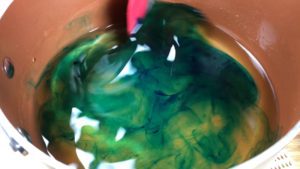
Use another colour to tint the little bowl of gelatin. Choose something that will show through the blue jelly so pink is a great option, or you can do a few bowls of different colours.

Use a measuring spoon or a dropper (a tiny turkey baster!) to fill in the fish shapes. If the gelatin overflows, dip a paper towel into it to mop it up. Put the mold in the fridge for an hour and then push the fish out!

The pros of gelatine fish are that they’re easier to cut through when you serve the cake than white chocolate fish, and you can use the gelatin you’re making anyway instead of needing another ingredient for the white chocolate fish.

The downside of gelatine fish is that the colours and texture aren’t as visible through the jelly ocean on the cake as on the white chocolate fish. When you see the finished cakes you can choose which ones you prefer.

Finally, we’re going to create the jelly ocean! Cut a piece of acetate so it’s long enough to wrap around your cake, and at least as high as you want the cake to be.

Spray the acetate with oil and wipe the oil with a paper towel so that there’s a thin coating all over the acetate. If you’re using a roll of acetate, spray the side that curves upwards, the side of the acetate that will touch the cake when the acetate wraps around it.

If you haven’t already, take the ring off your springform pan and place your cake on the base. The cake needs to be cold for this so that the frosting is firm and doesn’t get damaged when you move the cake around and wrap it with the acetate.

Make sure the cake is in the middle of the pan, with at least 1/2 a cm of a 1/4 of an inch all the way around if you want the entire sides of the cake to be jelly. I’ll show you the alternative next.

Wrap the acetate around the cake, around the base of the springform pan. Pull it tight and then tape the end of the acetate to make a tight seam from the top to the bottom, so that the jelly doesn’t leak out of the join of the two ends of the acetate.

Place the cake on the base onto a piece of cling film or Saran Wrap and lift the plastic up to wrap it around the acetate. Secure it tightly with a few pieces of tape. This will stop the jelly leaking out of the bottom of the acetate.

Then lower the ring of the springform pan down over the acetate and connect it to the base. The purpose of the cling film and tape is to make sure the jelly doesn’t leak out of the acetate but you can place your cake in a bowl just in case.

Once the jelly has cooled but before it sets, pour it slowly over the cake. Aim to hit the cake somewhere there isn’t a fish, so you don’t risk knocking it off the frosting where you placed it. If the jelly has cooled and the cake is chilled so the frosting is firm, the jelly won’t melt the frosting or blend with it, it will just sit on top of it.

You can see a bit of jelly leaking out here, so the bowl is a good idea just in case. If you wrap the acetate with cling film before you clip on the ring fo the springform pan and you tape it tightly enough, you shouldn’t have any leaking jelly.
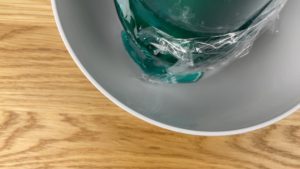
For this cake, you can see that at the bottom of the dome, the frosting on the cake goes right up to the acetate wrapped around it, so there’s no room for jelly, so the sand frosting will on the outside of the cake at the bottom.

Place gelatin fish around the cake, keeping the fish on the edges of the cake so they’ll be the most visible. Pour the gelatine over the cake to fill in the area around the cake up to the acetate,

Put the cake in the fridge for an hour to set the jelly. Then take it out of the fridge and unclip the springform pan, lifting it up over the top of the acetate.

Peel the tape off the acetate and unwrap the acetate. If the jelly has set and the acetate was greased with oil, the acetate will peel off easily and the jelly will stay behind, creating a smooth coating all around the cake.

If the frosting on the cake went all the way up to the acetate at the bottom of the cake, that frosting will be exposed when you peel off the acetate and the jelly ocean will start higher up on the cake. If any jelly seeped below when you want the ocean to start you can carefully peel off those thin patches of jelly.

Lift the cake off the springform base and spread some buttercream on a cake board or a plate to secure the cake on it.

If there’s any stray gelatin at the top of the cake, above the top edge, you can trim it off with scissors. This happens when some jelly leaks out of the cling film and the jelly part of the cake sinks a little bit lower, leaving some residue behind, higher up on the acetate where the top level of the jelly used to be.

If you want to add some edible sand around the bottom of the cake, pipe frosting around the base and straight away pour some brown sugar or crushed graham crackers onto the cake board and push them gently into the frosting, up against the cake.

You can use any piping tip, it doesn’t have to be round, or just squeeze the frosting out of the hole at the end of the bag without a piping tip. You can flatten the piped frosting with an

Cut into the cake just like you’d cut into any other cake! You’ll have to use a bit of pressure to cut through white chocolate fish. It’s fun having two very different flavours and textures in the same slice of cake, and the cross section of the cake looks stunning!

Whether you completely cover the cake in jelly or leave some frosting “sand” exposed, and whether you use jelly or white chocolate fish, this cake will be both delicious AND beautiful!

If you aren’t happy with your cake after removing the acetate, pull the jelly parts away from the frosted cake and put them in the microwave at 50% power for 30 seconds at a time to melt the jelly again.

Make any changes you want to your cake and then wrap it in acetate again, tape it with cling film, re-attach the springform pan and once the jelly is cool, pour it over the cake!
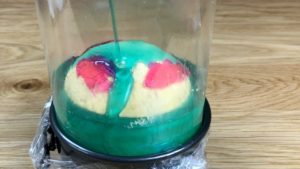
I hope this video has given you the tips and confidence to make your own under the sea jelly cake! Please tag me (@britishgirlbakes) in your photos on instagram so I can see your creation!

Here’s the video version of this tutorial:
